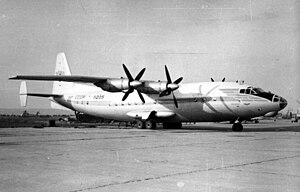The Antonov An-10 was a four-engined turboprop passenger transport aircraft designed and built in the Soviet Union in the 1950s and 1960s. It was developed alongside its military cargo counterpart, the Antonov An-12, and shared many features with it. It had a NATO reporting name of Cat.
Design and Development
The Antonov An-10 was designed by the Antonov Design Bureau under the leadership of Oleg Antonov. It was intended to replace the older piston-engined airliners such as the Ilyushin Il-12 and Il-14, and to compete with the Western turboprop airliners such as the Vickers Viscount and the Lockheed L-188 Electra.
The An-10 was based on the An-8, a twin-engined turboprop transport aircraft that first flew in 1956. The An-10 had a larger fuselage, a longer wingspan, and four Ivchenko AI-20M engines that gave it a maximum speed of 680 km/h and a range of 2,500 km. It had a pressurized cabin that could accommodate up to 132 passengers in a single-class configuration, or up to 85 passengers in a mixed-class configuration. It had a crew of five, including two pilots, a navigator, a flight engineer, and a radio operator.
The An-10 made its first flight on March 7, 1957, piloted by Yakov Vernikov. It underwent extensive testing and modifications before entering service with Aeroflot in 1959. It received its type certificate in 1960 and was displayed at the Paris Air Show in 1961.
Operational History
The An-10 was mainly used by Aeroflot for domestic and regional flights within the Soviet Union and its allies. It also served with some foreign airlines, such as United Arab Airlines, Syrian Arab Airlines, and Air Guinee. It was praised for its comfort, reliability, and performance, especially in hot and high conditions. It could operate from short and unpaved runways, thanks to its STOL (short take-off and landing) capabilities.
However, the An-10 also had some drawbacks and limitations. It had a high fuel consumption and noise level, which reduced its profitability and popularity among passengers. It also suffered from some structural problems and fatigue cracks, which led to several accidents and incidents. The most serious one occurred on May 18, 1972, when an Aeroflot An-10 crashed near Kharkiv, killing all 122 people on board. The investigation revealed that the crash was caused by the failure of the rear fuselage due to metal fatigue.
Following this accident, Aeroflot decided to withdraw all An-10s from service by 1974. Some of them were converted into cargo or special-purpose aircraft, such as the An-10A for aerial photography or the An-10TS for ice reconnaissance. The last An-10 flight took place in 1984. By then, most of them had been scrapped or stored.
Legacy
The Antonov An-10 was one of the first Soviet turboprop airliners and one of the most successful ones in terms of production and service. It carried more than 35 million passengers during its operational life and set several world records for speed, altitude, and payload2. It also paved the way for the development of other Antonov aircraft, such as the An-22, An-24, An-26, and An-32.
However, the An-10 also had a short service life compared to its Western counterparts, due to its technical issues and safety concerns. It was soon replaced by newer jet airliners such as the Tupolev Tu-134 and Tu-154, which offered higher speed, range, and capacity1. Today, only a few examples of the An-10 remain in museums or as monuments.

General characteristics
- Crew: 4 flight crew +cabin crew
- Capacity: 100 or 130 pax / 14,500 kg (32,000 lb)
- Length: 34 m (111 ft 7 in)
- Wingspan: 38 m (124 ft 8 in)
- Height: 9.83 m (32 ft 3 in)
- Wing area: 120 m2 (1,300 sq ft)
- Volume: 222 m3 (7,800 cu ft) cabin volume
- Underfloor hold volume: 32 m3 (1,100 cu ft)
- Max takeoff weight: 55,100 kg (121,475 lb)
- Fuel capacity: 13,000 L (3,400 US gal; 2,900 imp gal) (10,250 kg (22,600 lb))
- Powerplant: 4 × Ivchenko AI-20K turboprop engines, 3,000 kW (4,000 hp) each (equivalent)
- Propellers: 4-bladed AV-68 reversible-pitch constant-speed propellers, 4.5 m (14 ft 9 in) diameter
Performance
- Maximum speed: 715 km/h (444 mph, 386 kn)
- Cruise speed: 680 km/h (420 mph, 370 kn) maximum at 10,000 m (33,000 ft)
- Economical cruise speed: 630 km/h (390 mph; 340 kn) at 10,000 m (33,000 ft)
- Take-off speed: 190–210 km/h (120–130 mph; 100–110 kn)
- Range: 1,200 km (750 mi, 650 nmi) with max payload + 60 minutes reserve fuel
- 4,075 km (2,532 mi) with max fuel 8,440 kg (18,610 lb) payload and no reserves
- Service ceiling: 10,200 m (33,500 ft)
- Wing loading: 430 kg/m2 (88 lb/sq ft)
- Power/mass: 4.4 kg/kW (7.2 lb/hp)
- Landing run: 500–650 m (1,640–2,130 ft) with reverse pitch
